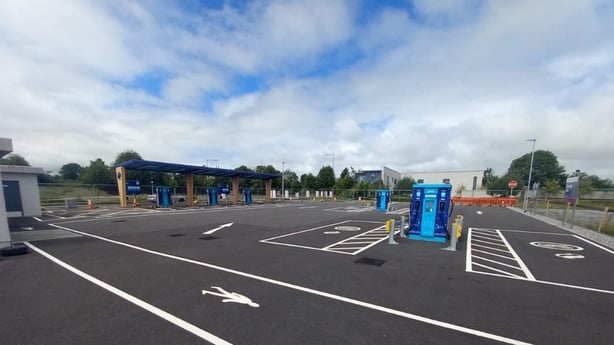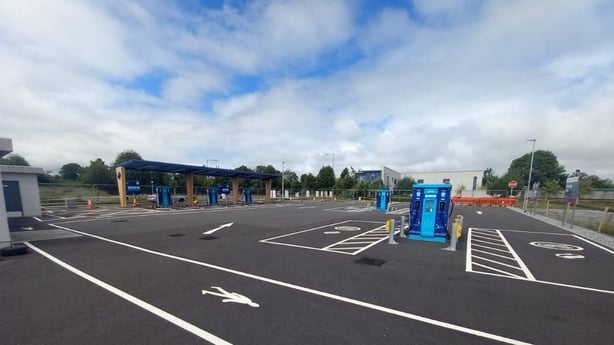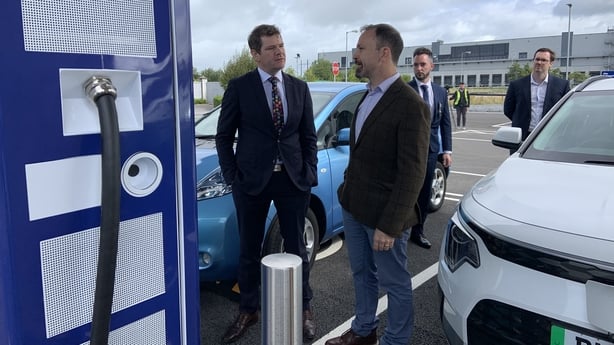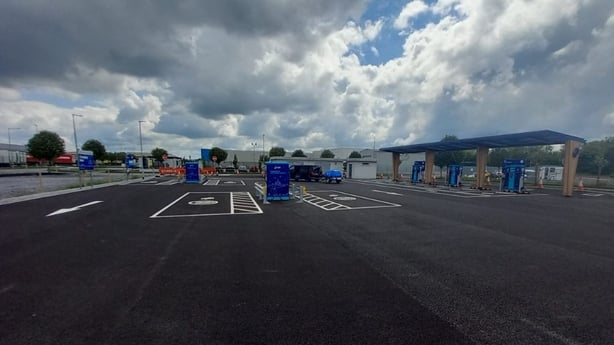SSE opens first public EV charging hub in Mullingar

A new ultra-rapid electric charging hub was officially opened this morning by Minister for Enterprise, Trade and Employment, Peter Burke, who said SSE's investment pivots into the Government's policy on decarbonisation. The number of charging points for electric vehicles across the country is a constant source of irritation and worry by the people who need them. At the moment there are just over 2,400 charging points, with a promise of 130 more by the end of next year.
SSE plans to build 300 more ten-bay hubs across Ireland and the UK over the next five years.
 The facility is located just off the M4 at Lough Sheever Corporate Park
The facility is located just off the M4 at Lough Sheever Corporate Park
The facility in Mullingar includes four long wheelbase drive-through bays purpose built for eHGVs, making it the first site of its kind in Ireland. Each ultra-rapid bay has charging capabilities of up to 150 kilowatts (kW), sufficient to deliver 12.5 kms of range per minute of charging. The facility, which is located just off the M4 at Lough Sheever Corporate Park, is part of SSE's plans to build 300 ultra-rapid EV charging hubs powered by traceable, renewable energy in the Ireland and the UK in the next five years with several sites already open and more under construction.
Mr Burke said they had a target to reach 30% of electric vehicles by 2030 and what people need for that is infrastructure, to ensure people have "the opportunity they won't get caught short". The Government's policy is to have charging infrastructure every 60 kms on major arteries and Mr Burke said the Mullingar hub fits into that policy objective.
 Peter Burke and Sean O'Callaghan at the opening in Mullingar today
Peter Burke and Sean O'Callaghan at the opening in Mullingar today
"It's very important that we keep on that path, it will take a lot of work. I think it'll take more improved grants, obviously, in relation to the capital infrastructure as well, which is very significant," said the Minister.
SSE will open further hubs at Blanchardstown Business Park and the Greenogue Industrial Estate in Dublin and at the Ashbourne Retail Park, Co Meath, in the coming months. SSE's EV Operations Director Sean O'Callaghan said they are working to build a network of easy-to-reach charging points across the country. "With the number of EVs on Irish roads growing quickly, the deployment of fast and reliable EV charging infrastructure is essential.
"The launch of our first ultra-rapid charging hub in Ireland is proof that SSE will support the Irish Government's ambitions to meet the demand for this infrastructure and this is just the beginning of our ambitions." Doubts over 2030 target as EV sales fall Latest figures from the Society of the Irish Motor Industry (SIMI) show that new electric car sales are down by 25% year to date.
The decline in EV sales[1], as well as recent reports of 'range anxiety' and inadequate charging infrastructure, has led to doubts over whether or not the target of getting one million EVs on Irish roads by 2030 is possible. However, Aoife O'Grady, head of the Zero Emission Vehicles Ireland (ZEVI) in the Department of Transport, said that the most important target is to get 30% of all vehicles in the country to run on electricity by 2030. That means buses, trucks and heavy goods vehicles (HGVs), along with cars.
Although the new SSE facility in Mullingar was completed without any ZEVI grants, Ms O'Grady said steps like this are promising and is keen that the market for EV charging stations be competitive, so that consumers can get better prices. More charging points off motorways are coming - with the State seeking to have 131 charging points delivered by the end of 2025. As part of charging infrastructure targets, ESB has a target of delivering 800mw of public charging infrastructure capacity.
Ms O'Grady said different kinds of charging stations need to be available in Ireland in order to reduce the electricity load on the grid and also to meet people's needs. She said the first priority of EV charging infrastructure is home charging. Around 80% houses have off-street parking, meaning EV charging can be done during off-peak hours, resulting in a cheaper 'refuelling' for the consumer and the least pressure on the electricity grid.
The next priority is neighbourhood charging. ZEVI is working with local authorities to set up areas where people can charge their cars overnight if they do not have off-street parking.
 SSE chose the Mullingar site as it is one of the busiest truck and heavy-duty circulating locations
SSE chose the Mullingar site as it is one of the busiest truck and heavy-duty circulating locations
Then there will be top-up charging points - allowing people to charge their car a little faster at between 30 minutes to an hour - at locations such as shopping centres, sports clubs and gyms. The final priority for private cars is ultra-rapid charging.
This is the fastest option and will generally be along motorways. While this would be the most expensive charging option, it would only take between five and ten minutes. The latest figures from the Central Statistics Office show that 12,765 EVs were licensed in Ireland between January and July of this year, a decline of nearly 25% compared with the same period last year.
Professor of Transportation at Trinity College Brian Caulfield described the trend as "very worrying".[2] SSE chose Lough Sheever Corporate Park in Mullingar as its first charging hub site because it is one of the busiest truck and heavy-duty vehicle circulating locations in the country. Mr O'Callaghan said the hub is specifically tailored to remove the barriers to fleets trying to electrify.
Although the hubs are anticipated to be mainly used by commercial vehicles, Mr O'Callaghan stressed that they are open to every kind of EV and more are coming. "We would hope to have quite a few sites up and running within the next 24 months and even more than that to follow. "Whether you are a van driver, truck driver, car driver, fleet business, driver, courier - anybody can drive up and use these," he said.
Additional reporting Eithne Dodd